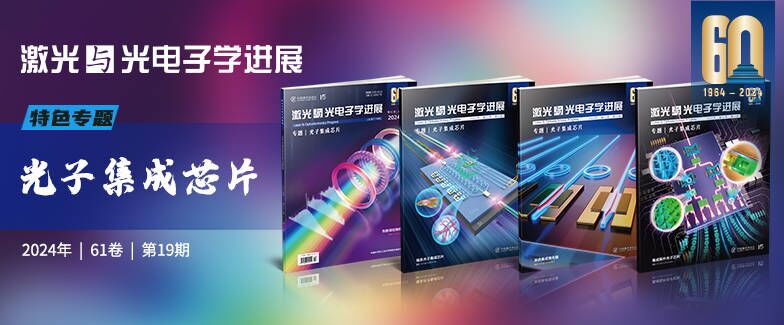Search by keywords or author
Journals >Laser & Optoelectronics Progress

Instrumentation, Measurement and Metrology
Yuanjun Wu, Cheng Pan, and Zhanhua Huang
Laser & Optoelectronics Progress
- Apr. 18, 2025
- Vol. 62, Issue 9 (2025)
Lasers and Laser Optics
Sizhu Wu, Xueli Gao, Jiawei Lu, Lu Zeng... and Zhixiang Gu|Show fewer author(s)
Laser & Optoelectronics Progress
- Apr. 18, 2025
- Vol. 62, Issue 9 (2025)
Detectors
Gengyun Wang, Bu Hongbo, and Weijun Pan
Laser & Optoelectronics Progress
- Apr. 15, 2025
- Vol. 62, Issue 9 (2025)
Reviews
Haonan Wang, Junfeng Liu, Zhuojiang Nan, and Wei Tao
Laser & Optoelectronics Progress
- Apr. 14, 2025
- Vol. 62, Issue 9 (2025)
Machine Vision
Heng Zhang, Xiaoqiang Zhang, Guanwu Jiang, Zhixin Zhang... and Xuliang Wang|Show fewer author(s)
Laser & Optoelectronics Progress
- Apr. 14, 2025
- Vol. 62, Issue 8 (2025)
On the Cover
With the continuous development of medicine, optics, chemistry, communication and other fields, various micro total analysis system, lab-on-a-chip, micro electro mechanical systems and high-precision micro-nano devices began to appear and are gradually used. Most of these systems or structures are realized by preparing three-dimensional micro-nano connected structures in transparent materials by femtosecond laser. Therefore, the main technologies of femtosecond laser preparation of three-dimensi
Laser & Optoelectronics Progress
- Sep. 13, 2024
- Vol. 60, Issue 21 (2023)
On the Cover
Non-diffracting beams have attracted attention in recent years due to their unique properties, such as diffraction-free propagation and self-repairing and self-accelerating ability, which make them promising candidates for microscopic imaging applications. Non-diffraction beams can suppress beam diffraction during propagation, thereby improving the imaging resolution. Moreover, their self-healing characteristic facilitates quick wave-front recovery after passing through a strongly scattering med
Laser & Optoelectronics Progress
- Sep. 13, 2024
- Vol. 60, Issue 20 (2023)
On the Cover
Laser-induced forward transfer has application prospects in three-dimensional metal microstructure printing. Pulse duration is a critical factor that influences the droplet transfer behavior, but droplet generation and deposition behavior under different pulse durations are unclear at present. In this study, 500 nm copper films were used as the research object to perform a laser-induced forward transfer experiment at five pulse durations. The results show that with an increase in pulse duration,
Laser & Optoelectronics Progress
- Sep. 13, 2024
- Vol. 60, Issue 19 (2023)
On the Cover
As an important device for the application of terahertz technology, the terahertz modulator has a wide application prospect in the fields of terahertz communication, imaging, and sensing. However, current terahertz modulators exhibit problems, such as low modulation depth, narrow operating bandwidth, and poor stability. This restricts further promotion and development of terahertz technology. In this study, a new optical control GaAs/side-polished terahertz fiber (SPTF) modulator is demonstrated
Laser & Optoelectronics Progress
- Sep. 13, 2024
- Vol. 60, Issue 18 (2023)
Top Downloads
- Laser & Optoelectronics Progress
- Vol. 61, Issue 21, 2125001 (2024)
- Laser & Optoelectronics Progress
- Vol. 61, Issue 19, 1913014 (2024)
Multi-Aperture Optical-Fiber Imaging Technology with Mid-Wave Infrared Large Field-of-View (Invited)
- Laser & Optoelectronics Progress
- Vol. 61, Issue 20, 2011013 (2024)
- Laser & Optoelectronics Progress
- Vol. 61, Issue 16, 1611008 (2024)
- Laser & Optoelectronics Progress
- Vol. 61, Issue 16, 1611001 (2024)
- Laser & Optoelectronics Progress
- Vol. 61, Issue 16, 1611002 (2024)














